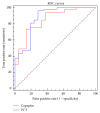Assessment of Diagnostic and Prognostic Role of Copeptin in the Clinical Setting of Sepsis
- PMID: 27366743
- PMCID: PMC4913060
- DOI: 10.1155/2016/3624730
Assessment of Diagnostic and Prognostic Role of Copeptin in the Clinical Setting of Sepsis
Abstract
The diagnostic and prognostic usefulness of copeptin were evaluated in septic patients, as compared to procalcitonin assessment. In this single centre and observational study 105 patients were enrolled: 24 with sepsis, 25 with severe sepsis, 15 with septic shock, and 41 controls, divided in two subgroups (15 patients with gastrointestinal bleeding and 26 with suspected SIRS secondary to trauma, acute coronary syndrome, and pulmonary embolism). Biomarkers were determined at the first medical evaluation and thereafter 24, 48, and 72 hours after admission. Definitive diagnosis and in-hospital survival rates at 30 days were obtained through analysis of medical records. At entry, copeptin proved to be able to distinguish cases from controls and also sepsis group from septic shock group, while procalcitonin could distinguish also severe sepsis from septic shock group. Areas under the ROC curve for copeptin and procalcitonin were 0.845 and 0.861, respectively. Noteworthy, patients with copeptin concentrations higher than the threshold value (23.2 pmol/L), calculated from the ROC curve, at admission presented higher 30-day mortality. No significant differences were found in copeptin temporal profile among different subgroups. Copeptin showed promising diagnostic and prognostic role in the management of sepsis, together with its possible role in monitoring the response to treatment.
Figures




References
-
- Dellinger R. P., Levy M. M., Rhodes A., et al. Surviving Sepsis Campaign: international guidelines for management of severe sepsis and septic shock: 2012. Critical Care Medicine. 2013;41580637 - PubMed
Publication types
MeSH terms
Substances
LinkOut - more resources
Full Text Sources
Other Literature Sources
Medical

